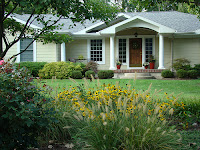When selling a home, things as simple as making sure each bed, especially the one in the master bedroom, has a headboard can make a big difference. This gives the room a more finished look and can often be the focal point in a room.
Don’t worry! I’m not going to suggest you go out and buy a headboard. There are many simple, inexpensive ways to add one (or even the appearance of having one). Headboards are also great places to add color and texture. Here are just a few suggestions.
Curtains: Hang a curtain rod behind the bed, as close to the ceiling as possible, and add curtains that coordinate with the other colors in the room.
This is an example that uses both curtains and shades.
Copyright 2012 by Kristen DiNobile
Molding: You can purchase inexpensive molding and trim pieces at home improvement stores. Pre-primed pieces make the project go faster. Hang them horizontally and vertically to create the appearance of custom paneling.
This homeowner went a step further and used molding as an outline for another material. Fabric, wallpaper, or paint would all work here.
Copyright 2010 by It's Great to be Home
Wainscoting: You can buy pre-primed pieces of wainscoting. Simply hang them behind the bed. The number of panels you need will of course vary based on the size of your bed. The height is really a matter of personal preference. Just make sure the size fits the proportions of that particular room.
Doors: Find an old wood door and mount it horizontally behind the bed. It might look great “as is” or it may need a good sanding and a coat of paint or stain. If you have 2 doors you can do the same thing, but hang them vertically, side by side. This technique also works with shutters or room divider screens.
Paint the entire door one color, paint the inserts a different color, or just hang "as is" for a rustic look.
Copyright 2010 by David Jaquin
Fabric: This idea requires very basic DIY skills. Cut a piece of plywood or MDF to the dimensions of a headboard for your bed size (such as queen or king). Many home improvement stores will do this for you. Add some batting or stuffing. Finally, cover the entire piece with inexpensive fabric or even a leftover sheet, blanket or quilt. The fabric can be attached with a heavy duty staple gun, which can be found at home improvement stores for as low as $20.
An alternative to this idea is to use 12” square pieces of plywood, MDF, or even cork board. Cover each piece with batting and fabric in the same way described above. Hang them in a checkerboard pattern. You can use the same fabric or mix and match to create a pattern.
The squares work great if you have leftover fabric that is not enough to cover an entire headboard, but could be cut to fit smaller squares and then mixed with other leftover fabric pieces.
Making your own fabric headboard leaves lots of room for creativity in the choice of fabric, You can vary the material, pattern and/or color.

This headboard uses just a simple, single color fabric.
Copyright 2010 by Iriskh
Paint: Use paint to create a checkerboard pattern on the wall behind the bed. Use painters' tape to create squares or any other design pattern. You can even outline the the finished painted area with strips of molding. Stripes work as well but make sure they either go from floor to ceiling or you use molding to outline the pattern. One color option is to use tone on tone squares, which are neutral and sophisticated.
Bookcases: Place 2 bookcases behind your bed. They can double as nightstands. Just make sure not to add too much clutter on the shelves. You could also turn them around if the backs are finished and look appealing (or you could even paint the backs.) Visit furniture retailers and design sites and use the photos there as inspiration for creating your own inexpensive versions.
These are really just a few ideas to get you brainstorming on your own.
Look through your garage, basement, or attic and hit yard sales. Look for something that can be turned into a headboard. Don't forget that there are many inexpensive tools that can help you transform these items. Headboards are just one of the many finishing touches you can add to a staged home that only give the appearance that you spent a fortune.











